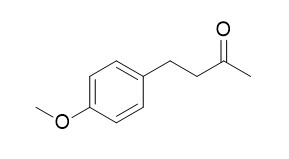4-(4-Methoxyphenyl)-2-butanone
4-(4-Methoxyphenyl)-2-butanone is an effective lure for the male melon fly (Dacus cucurbitae Coq.)
Inquire / Order:
manager@chemfaces.com
Technical Inquiries:
service@chemfaces.com
Tel:
+86-27-84237783
Fax:
+86-27-84254680
Address:
1 Building, No. 83, CheCheng Rd., Wuhan Economic and Technological Development Zone, Wuhan, Hubei 430056, PRC
Providing storage is as stated on the product vial and the vial is kept tightly sealed, the product can be stored for up to
24 months(2-8C).
Wherever possible, you should prepare and use solutions on the same day. However, if you need to make up stock solutions in advance, we recommend that you store the solution as aliquots in tightly sealed vials at -20C. Generally, these will be useable for up to two weeks. Before use, and prior to opening the vial we recommend that you allow your product to equilibrate to room temperature for at least 1 hour.
Need more advice on solubility, usage and handling? Please email to: service@chemfaces.com
The packaging of the product may have turned upside down during transportation, resulting in the natural compounds adhering to the neck or cap of the vial. take the vial out of its packaging and gently shake to let the compounds fall to the bottom of the vial. for liquid products, centrifuge at 200-500 RPM to gather the liquid at the bottom of the vial. try to avoid loss or contamination during handling.
Food Science and Biotechnology2023, 2023:1007
Vet World.2023, 16(3):618-630.
The Journal of Internal Korean Medicine2015, 36(4):486-497
Drug Dev Res.2022, 83(7):1673-1682.
Biol Pharm Bull.2018, 41(11):1685-1693
Appl. Sci.2020, 10(23), 8729
Research SPJ.2024, 0377.
Oncol Rep.2019, 41(4):2453-2463
J Nat Prod.2022, doi: 10.1021
Food Chem.2023, 424:136383.
Related and Featured Products
Journal of Agricultural and Food Chemistry, 1962, 10(4):270-276.
Insect Attractants, The Development of Male Melon Fly Attractants.[Reference:
WebLink]
METHODS AND RESULTS:
The finding that anisylacetone [4-(p-methoxyphenyl)-2-butanone, 4-(4-Methoxyphenyl)-2-butanone] was an effective lure for the male melon fly (Dacus cucurbitae Coq.) led to an investigation of related compounds, especially 4-aryl-2-butanones, to find better lures. The attractancy ratings of 119 compounds and their relationships between chemical structure and ability to lure are reported. Syntheses of many of the compounds and physical constants of the new ones are given.
CONCLUSIONS:
The best attractant, 4-(p-acetoxyphenyl)-2-butanone, now known as cue-lure, trapped more than 20 times as many flies as anisylacetone.



